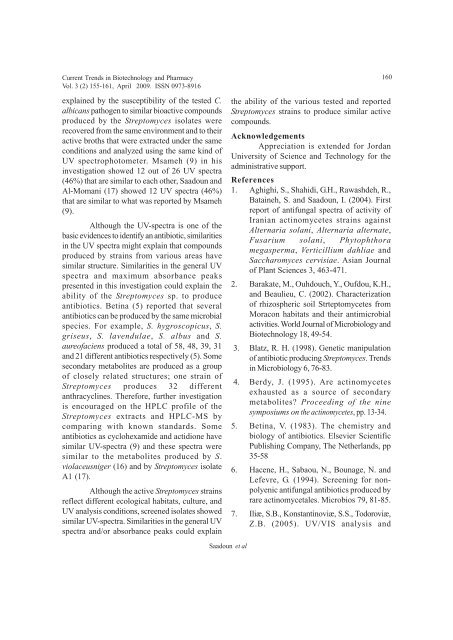April Journal-2009.p65 - Association of Biotechnology and Pharmacy
April Journal-2009.p65 - Association of Biotechnology and Pharmacy
April Journal-2009.p65 - Association of Biotechnology and Pharmacy
Create successful ePaper yourself
Turn your PDF publications into a flip-book with our unique Google optimized e-Paper software.
Current Trends in <strong>Biotechnology</strong> <strong>and</strong> <strong>Pharmacy</strong><br />
Vol. 3 (2) 155-161, <strong>April</strong> 2009. ISSN 0973-8916<br />
explained by the susceptibility <strong>of</strong> the tested C.<br />
albicans pathogen to similar bioactive compounds<br />
produced by the Streptomyces isolates were<br />
recovered from the same environment <strong>and</strong> to their<br />
active broths that were extracted under the same<br />
conditions <strong>and</strong> analyzed using the same kind <strong>of</strong><br />
UV spectrophotometer. Msameh (9) in his<br />
investigation showed 12 out <strong>of</strong> 26 UV spectra<br />
(46%) that are similar to each other, Saadoun <strong>and</strong><br />
Al-Momani (17) showed 12 UV spectra (46%)<br />
that are similar to what was reported by Msameh<br />
(9).<br />
Although the UV-spectra is one <strong>of</strong> the<br />
basic evidences to identify an antibiotic, similarities<br />
in the UV spectra might explain that compounds<br />
produced by strains from various areas have<br />
similar structure. Similarities in the general UV<br />
spectra <strong>and</strong> maximum absorbance peaks<br />
presented in this investigation could explain the<br />
ability <strong>of</strong> the Streptomyces sp. to produce<br />
antibiotics. Betina (5) reported that several<br />
antibiotics can be produced by the same microbial<br />
species. For example, S. hygroscopicus, S.<br />
griseus, S. lavendulae, S. albus <strong>and</strong> S.<br />
aure<strong>of</strong>aciens produced a total <strong>of</strong> 58, 48, 39, 31<br />
<strong>and</strong> 21 different antibiotics respectively (5). Some<br />
secondary metabolites are produced as a group<br />
<strong>of</strong> closely related structures; one strain <strong>of</strong><br />
Streptomyces produces 32 different<br />
anthracyclines. Therefore, further investigation<br />
is encouraged on the HPLC pr<strong>of</strong>ile <strong>of</strong> the<br />
Streptomyces extracts <strong>and</strong> HPLC-MS by<br />
comparing with known st<strong>and</strong>ards. Some<br />
antibiotics as cyclohexamide <strong>and</strong> actidione have<br />
similar UV-spectra (9) <strong>and</strong> these spectra were<br />
similar to the metabolites produced by S.<br />
violaceusniger (16) <strong>and</strong> by Streptomyces isolate<br />
A1 (17).<br />
Although the active Streptomyces strains<br />
reflect different ecological habitats, culture, <strong>and</strong><br />
UV analysis conditions, screened isolates showed<br />
similar UV-spectra. Similarities in the general UV<br />
spectra <strong>and</strong>/or absorbance peaks could explain<br />
160<br />
the ability <strong>of</strong> the various tested <strong>and</strong> reported<br />
Streptomyces strains to produce similar active<br />
compounds.<br />
Acknowledgements<br />
Appreciation is extended for Jordan<br />
University <strong>of</strong> Science <strong>and</strong> Technology for the<br />
administrative support.<br />
References<br />
1. Aghighi, S., Shahidi, G.H., Rawashdeh, R.,<br />
Bataineh, S. <strong>and</strong> Saadoun, I. (2004). First<br />
report <strong>of</strong> antifungal spectra <strong>of</strong> activity <strong>of</strong><br />
Iranian actinomycetes strains against<br />
Alternaria solani, Alternaria alternate,<br />
Fusarium solani, Phytophthora<br />
megasperma, Verticillium dahliae <strong>and</strong><br />
Saccharomyces cervisiae. Asian <strong>Journal</strong><br />
<strong>of</strong> Plant Sciences 3, 463-471.<br />
2. Barakate, M., Ouhdouch, Y., Oufdou, K.H.,<br />
<strong>and</strong> Beaulieu, C. (2002). Characterization<br />
<strong>of</strong> rhizospheric soil Strteptomycetes from<br />
Moracon habitats <strong>and</strong> their antimicrobial<br />
activities. World <strong>Journal</strong> <strong>of</strong> Microbiology <strong>and</strong><br />
<strong>Biotechnology</strong> 18, 49-54.<br />
3. Blatz, R. H. (1998). Genetic manipulation<br />
<strong>of</strong> antibiotic producing Streptomyces. Trends<br />
in Microbiology 6, 76-83.<br />
4. Berdy, J. (1995). Are actinomycetes<br />
exhausted as a source <strong>of</strong> secondary<br />
metabolites Proceeding <strong>of</strong> the nine<br />
symposiums on the actinomycetes, pp. 13-34.<br />
5. Betina, V. (1983). The chemistry <strong>and</strong><br />
biology <strong>of</strong> antibiotics. Elsevier Scientific<br />
Publishing Company, The Netherl<strong>and</strong>s, pp<br />
35-58<br />
6. Hacene, H., Sabaou, N., Bounage, N. <strong>and</strong><br />
Lefevre, G. (1994). Screening for nonpolyenic<br />
antifungal antibiotics produced by<br />
rare actinomycetales. Microbios 79, 81-85.<br />
7. Iliæ, S.B., Konstantinoviæ, S.S., Todoroviæ,<br />
Z.B. (2005). UV/VIS analysis <strong>and</strong><br />
Saadoun et al













